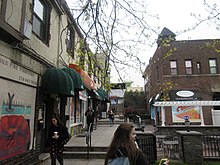Our website is made possible by displaying online advertisements to our visitors.
Please consider supporting us by disabling your ad blocker.
Murder of Kitty Genovese
| Murder of Kitty Genovese | |
|---|---|
 A 2019 view of the alleyway where Kitty Genovese was murdered | |
| Location | Kew Gardens, Queens, New York, U.S. |
| Date | March 13, 1964 |
Attack type | Murder by stabbing |
| Victim | Catherine "Kitty" Susan Genovese |
| Perpetrator | Winston Moseley |
| Verdict | Guilty on all counts |
| Convictions |
|
| Trial | June 8–11, 1964 |
| Sentence | 1964: Death 1967: Commuted to life imprisonment with the possibility of parole (never granted)[1] |
In the early hours of March 13, 1964, Kitty Genovese, a 28-year-old bartender, was raped and stabbed outside the apartment building where she lived in the Kew Gardens neighborhood of Queens, New York, United States.[2][3][4] Two weeks after the murder, The New York Times published an article erroneously claiming that thirty-seven witnesses saw or heard the attack, and that none of them called the police or came to her aid.[5] The incident prompted inquiries into what became known as the bystander effect, or "Genovese syndrome",[6] and the murder became a staple of U.S. psychology textbooks for the next four decades.
Researchers have since uncovered major inaccuracies in the Times article, and police interviews revealed that some witnesses had attempted to contact authorities. In 1964, reporters at a competing news organization discovered that the Times article was inconsistent with the facts, but they were unwilling at the time to challenge Times editor Abe Rosenthal. In 2007, an article in the American Psychologist found "no evidence for the presence of 38 witnesses, or that witnesses observed the murder, or that witnesses remained inactive".[7] In 2016, the Times called its own reporting "flawed", stating that the original story "grossly exaggerated the number of witnesses and what they had perceived".[8]
Winston Moseley, a 29-year-old Manhattan native, was arrested during a house burglary six days after the murder. While in custody, he confessed to killing Genovese. At his trial, Moseley was found guilty of murder and sentenced to death. His sentence was later commuted to life imprisonment. Moseley died in prison on March 28, 2016, at the age of 81, having served 52 years.[8]
- ^ McFadden, Robert D. (April 4, 2016). "Winston Moseley, Who Killed Kitty Genovese, Dies in Prison at 81". The New York Times.
- ^ "Queens Woman Is Stabbed to Death in Front of Home". The New York Times. New York City. March 14, 1964. p. 26. Retrieved July 5, 2007.
- ^ Thomas, Kristin (June 8, 2018). "The murder of "Kitty" Genovese that led to the Bystander Effect". Vintage News. Retrieved August 6, 2019.
She parked her car and started walking towards her apartment building, when she noticed a man standing at the corner end of the parking lot. Genovese nervously kept walking. Moseley had caught up to her, close to her apartment building, when he took his first stab.
- ^ Kilgannon, Corey (April 6, 2016). "Queens Neighborhood Still Haunted by Kitty Genovese's Murder". The New York Times. New York City. Retrieved August 6, 2019.
When Ms. Genovese, 28, was raped and murdered on her way home to her apartment.
- ^ Cite error: The named reference
nytimesarticlewas invoked but never defined (see the help page). - ^ Dowd, Maureen (March 12, 1984). "20 years after the murder of Kitty Genovese, The question remains: Why?". The New York Times. p. B1. Retrieved July 5, 2007.
- ^ Manning, Rachel; Levine, Mark; Collins, Alan (September 2007). "The Kitty Genovese Murder and the Social Psychology of Helping: The Parable of the 38 Witnesses". American Psychologist. 62 (6). Washington, D.C.: American Psychological Association: 555–562. CiteSeerX 10.1.1.210.6010. doi:10.1037/0003-066x.62.6.555. PMID 17874896.
- ^ a b McFadden, Robert D. (April 4, 2016). "Winston Moseley, 81, Killer of Kitty Genovese, Dies in Prison". The New York Times. New York City. Archived from the original on September 9, 2018. Retrieved November 26, 2019.
Previous Page Next Page


